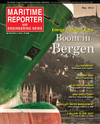
Page 24: of Maritime Reporter Magazine (May 2013)
Energy Production & Transportation
Read this page in Pdf, Flash or Html5 edition of May 2013 Maritime Reporter Magazine
24 Maritime Reporter & Engineering News ? MAY 2013 FAST CRAFT erate the advanced systems and proce-dures now being deployed on RHIBs and high speed craft. The conference will highlight the work being undertaken to develop qualifications appropriate to the pro-fessional sub 80 ft. (24 m) sector and how these can be utilized by the inter- national community. SimulationFor ship maritime operations, in-cluding bridge and control room, sim-ulation is recognized as an effective training tool. In other sectors, includ-ing aviation, it is an essential training tool. The sub 24m sector has not yet ef-fectively embraced simulation but this is about to change. There are many reasons for this but a fundamental requirement is the in-creasing deployment of sophisticated electronic systems for those operating at high speed in demanding environ-ments. Relevant simulation can be used to effectively support training and qualification programs. It can provide a controlled environ-ment that does not require use of a boat or fuel. The conference will high- light the different types of simulation and how operators can effectively use simulation to enhance operational ef-fectiveness and safety. Whole Body Vibration & Repeated Shock (WBV & RS) The risks of exposing fast craft crews and passengers to WBV & RS have now been recognized. Sys-tems have been developed to reduce or manage the exposure. Besides the obvious risk of acute and chronic in-jury RS & WBV can induce fatigue and degrade the interaction between the crew and the craft. The drive for legal compliance within the EU and employers needing to demonstrate duty-of-care in the rest of the world has driven the pace of development. Although reducing the risk to zero is virtually impossible for planing craft at sea, operators are now engaging with the concept of ALARP (As Low As Reasonably Practicable). The con- ference will highlight developments related to the management and control of exposure to WBV & RS. Unmanned Surface Vehicles (USV) The rapid development of un-manned vessels and systems is due to a number of factors. The drive for reduced manning can be due to cost and recruitment issues. The manning of craft can constrain the operational envelope and in certain applications ?unmanned? can simply remove the human from harms way. Although remote control systems are not new, the technical developments that are leading to more autonomous systems are changing the face of fast craft op-erations. The conference will high- light the developments in unmanned systems and the opportunities for the marine sector that these developments bring.OperationsFor the modern RHIB and high speed craft organization all of the top- ics described above then need to be integrated to deliver operational ca-pability. The technical developments and sys-tems to support human effectiveness provide the ability to either enhance the operational envelope or provide more resilience within the system for current operations. The conference will examine how fast craft operations are changing and what the future may hold for the crews and their organisa- tions.Emerging maritime nations have the opportunity to use the integration template to develop fast craft capabil-ities based on international best prac-tice. For established maritime organi- zations the challenge in these times of austerity is having clear reasons for where to apply their efforts and budgets when replacing or upgrad-ing craft. This approach can benefit all sectors from ships being replaced with multiple small craft fleets to the challenges of renewable energy sup- port craft.FRC International are hosting the CSI 2013 conference at the RNLI Col-lege in Poole UK from July 2-4, 2013. Dr Trevor Dobbins, Technical Direc- tor of FRC International, said, ?the 2013 event has a focused program that includes more than 20 presenta-tions by international experts. The objective is to bring together all the topics of Crew Systems Integration to show how marine operations in all sectors can benefit from a joined up approach.? The conference also gives industry the opportunity to participate with an exhibition area designed to highlight the latest developments in technology for RHIBs and high speed craft.CSI 2013 is an independent event that is relevant to all professional operators, boat builders, equipment manufacturers and designers. To highlight the importance of CSI for the international community keynote presentations are by leading experts including, former Royal Navy Rear Admiral Chris Parry, who was Direc- tor of Concept and Doctrine Develop-ment for the UK Ministry of Defence, and is now a noted strategic consul-tant and geopolitical forecaster. For further information see CSI 2013 Conference www.frc-int.com MR #5 (18-25).indd 24MR #5 (18-25).indd 244/30/2013 9:44:37 AM4/30/2013 9:44:37 AM

 23
23

 25
25
